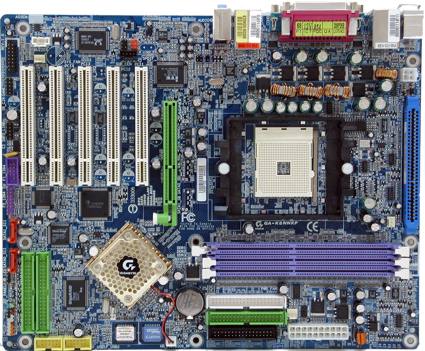Generation Change: Eight Motherboards For The Athlon 64
Gigabyte GA-K8NNXP
Board Revision: 1.0
BIOS Version: M15 (October 17, 2003)
We received two boards to test from Gigabyte, one with nForce3 (K8NNXP) and a second with K8T800 (K8VNXP). The pair share a lack of Cool & Quiet support. Instead they have CPU Smart, a feature that controls CPU fan speed. Still, you have to ask why it doesn't do the same to the two other prattleboxes on the DPS module and the Northbridge, since they are always audible, even if they're not really loud.
The DPS (dual power system) module has its own additional three phase voltage regulator that should be switched to those already on the board. Gigabyte's aim here is to achieve the voltage quality of a six phase switch. The DPS is placed in such a way that a flow of air between the CPU fan and the power supply is seriously disrupted. However, the whole thing only makes sense if a separate case fan extracts the waste heat to the rear as it arises.
Gigabyte outdid itself with the extras as familiar from earlier boards. Besides DPS, the board has an IDE RAID controller (GigaRAID), a Silicon Image SATA chip (Sil3512), a two port FireWire controller by Texas Instruments as well as another port based on 1394b / FireWire 800, DualBIOS to protect against BIOS damage, three DIMM sockets and an Ethernet controller from Realtek that can handle 1 Gbit/s. There is a secondary connection with 100 Mbit/s, too.
Gigabyte has also acquired the bad habit of supplying test devices for the press with tuned up BIOS versions. The M15 version takes the system speed up to a lightning 208 MHz, so that 2,080 MHz was achieved rather than the intended 2,000 MHz. In technical terms, the resulting differences between these boards and corresponding models from the competition just do not exist. In the absence of a newer BIOS, we selected the speed to be close to the specified 200.0 MHz. We achieved 201 MHz, which corresponds to a 0.5% increase. Not exactly desirable but within the bounds of tolerance.
Get Tom's Hardware's best news and in-depth reviews, straight to your inbox.
Current page: Gigabyte GA-K8NNXP
Prev Page Epox EP-8HDA3+, Continued Next Page Gigabyte GA-K8NNXP, Continued
Patrick Schmid was the editor-in-chief for Tom's Hardware from 2005 to 2006. He wrote numerous articles on a wide range of hardware topics, including storage, CPUs, and system builds.
